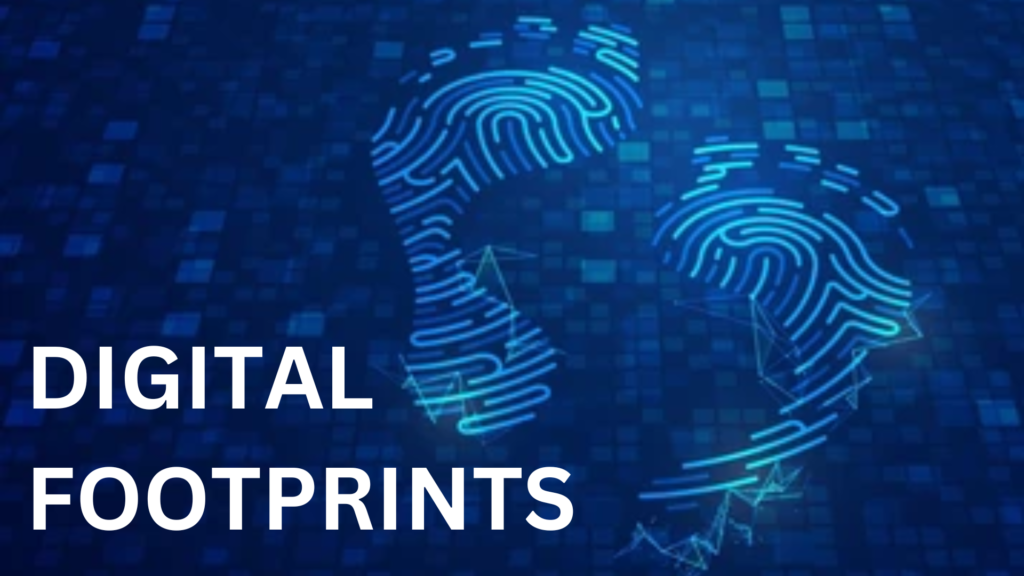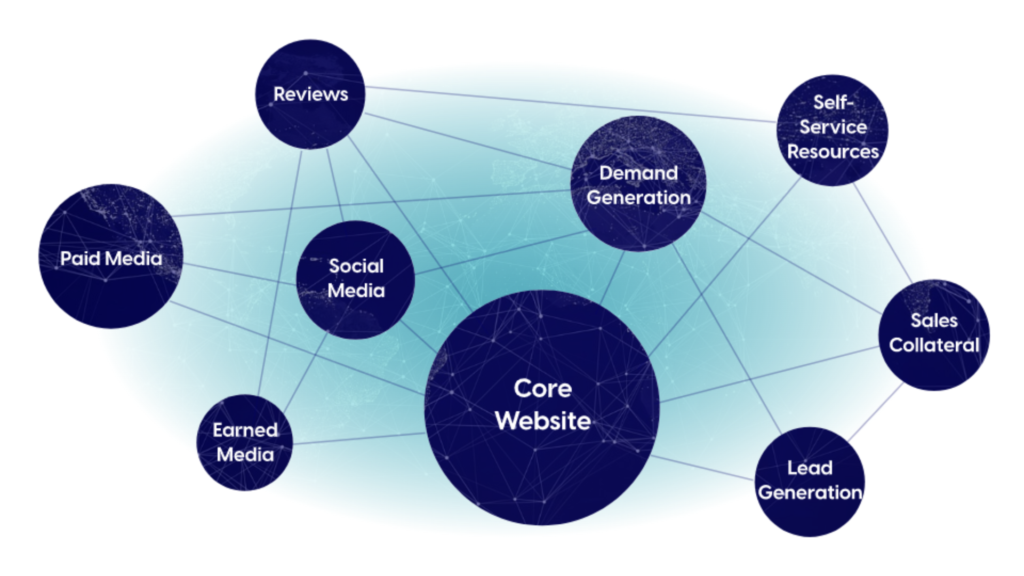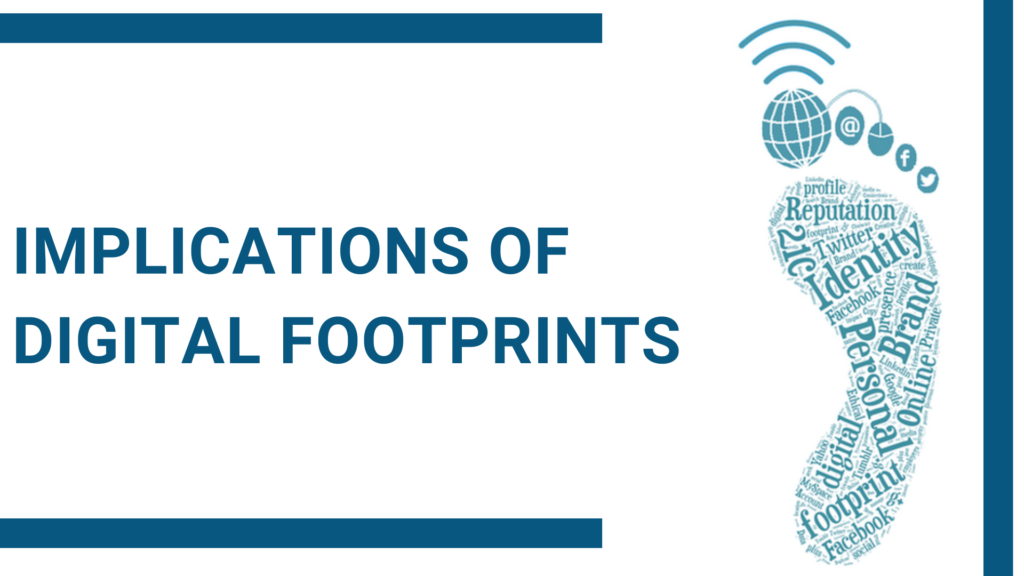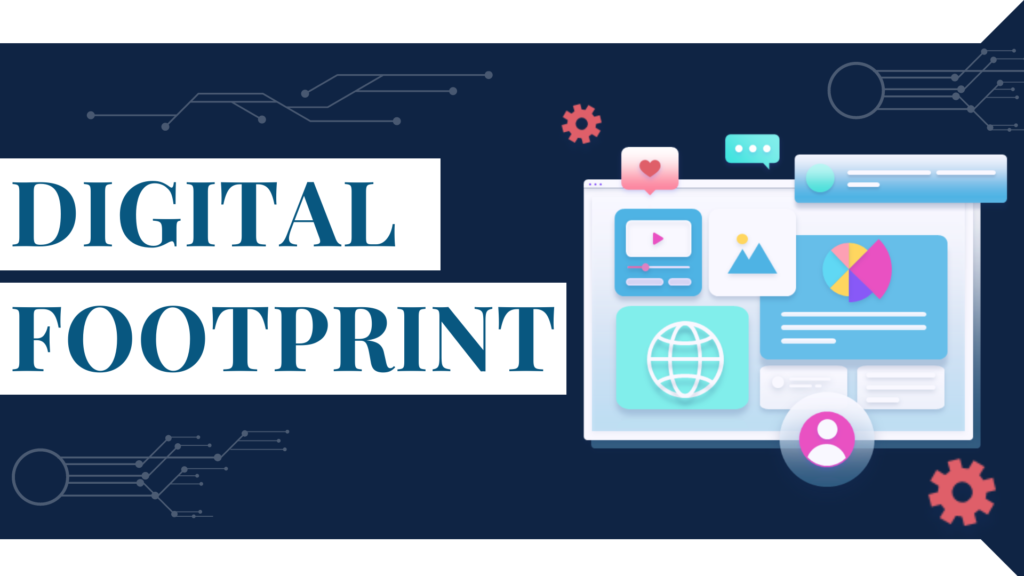In the age of technology and interconnectedness, our lives have become increasingly intertwined with the digital realm. From browsing the web to engaging in social media, we leave behind a digital trail known as our “digital footprint.” This footprint is a collection of data and information that reflects our online activities, and it holds the potential to shape our digital identities. In this article, we explore the concept of digital footprints, their implications, and the importance of understanding and managing them in today’s digital landscape.
What is Digital Footprint?

A digital footprint is the digital representation of an individual’s online presence. It comprises the traces and records left behind when we engage in various activities on the internet. These activities include browsing websites, posting on social media, making online purchases, using search engines, and communicating via email or messaging platforms. Each action generates data that contributes to our digital footprint, forming a mosaic of our online behavior.
In terms of digital footprints, there are two types of digital footprints: passive and active. Passive footprints are left when information is collected without the user’s knowledge. By using social media sites or by using websites, a user leaves an active digital footprint, which is information they intentionally share about themselves.
Components of Digital Footprint

Personal Information: When we create online accounts or provide personal details while using online services, we contribute to our digital footprints. This information may include our name, email address, phone number, birth date, and sometimes even more sensitive data like our home address.
Social Media Activity: Social media platforms have become a significant part of many people’s lives. Every post, comment, like, and share we make contributes to our digital footprint. This activity not only reflects our interests and opinions but also creates a searchable record of our online behavior.
Online Purchases and Transactions: When we make purchases online or engage in financial transactions, we leave behind a digital trace. This can include details such as our payment information, shopping preferences, and browsing history, which contribute to our digital footprints.
Web Browsing History: Our browsing habits, the websites we visit, and the searches we perform contribute to our digital footprints. Internet service providers, search engines, and website analytics tools often collect this data to personalize our online experiences and deliver targeted advertisements.
The Implications of Digital Footprints

Permanence: One of the most significant aspects of digital footprints is their longevity. Once data is generated and shared online, it can be challenging to completely erase or control its dissemination. Even if we delete content or close accounts, remnants of our digital footprints can still exist in backups or be accessed by third parties.
Reputation and Privacy: Digital footprints can significantly impact our reputation and privacy. Potential employers, educational institutions, and even acquaintances often search for online information to form opinions about us. Inappropriate or controversial content can have far-reaching consequences and affect various aspects of our lives.
Targeted Advertising and Personalization: Companies leverage digital footprints to deliver targeted advertisements and personalized content. By analyzing our online behavior, they can tailor their offerings to our interests and preferences. While this can enhance user experiences, it also raises concerns about privacy and the potential manipulation of consumer choices.
How to Managing Your Digital Footprint

Managing your digital footprint is important for maintaining your online reputation, protecting your privacy, and controlling the information associated with you online. You can manage your digital footprint by following these tips:
- Regularly Google Yourself: Start by searching your name on popular search engines to see what information is readily available about you online. This will give you an idea of what others can find when they search for you.
- Review Your Social Media Profiles: Go through your social media accounts and review the privacy settings. Make sure you understand who can see your posts, photos, and personal information. Adjust the settings according to your preferences, and consider making some information private or visible only to close friends.
- Be Mindful Of What You Share: Think twice before sharing personal information, photos, or opinions online. It can be difficult to remove something from the Internet once it’s been posted. Be cautious about sharing sensitive information such as your address, phone number, or financial details.
- Monitor Your Online Accounts: Regularly check your social media accounts, email, and other online platforms for any suspicious activities or unauthorized access. In order to increase security, use two-factor authentication whenever possible.
- Clean Up Your Digital Presence: If you find any information or posts that you are not comfortable with, try to remove or delete them. Contact the respective platforms or websites if necessary to request the removal of any unwanted content.
- Use Strong And Unique Passwords: Ensure that all your online accounts have strong, unique passwords. Keep passwords unique and do not reuse them across accounts. Consider using a password manager to securely store and generate complex passwords.
- Limit Personal Information Online: Be cautious about providing personal information on websites, online forms, or social media profiles. Minimize the amount of personal information you share, especially on public platforms.
- Think Before Tagging Or Mentioning Others: Make sure you have their consent when tagging or mentioning others in posts or photos. Respect their privacy and avoid sharing sensitive or embarrassing content without their permission.
- Educate Yourself About Privacy Settings: Stay informed about the privacy settings and options available on different platforms. Understood how Regularly update your software and devices: Keep your devices, operating systems, and applications up to date with the latest security patches. This helps protect against potential vulnerabilities and keeps your digital presence secure.
Remember that managing your digital footprint is an ongoing process. Regularly review and update your online presence to ensure that it aligns with your personal and professional goals.
Role of Digital Footprints In Career

Digital footprints play a significant role in shaping one’s career in the digital age. A digital footprint refers to the trail of data or information that individuals leave behind when they engage in online activities. These footprints can include social media posts, online comments, blog articles, forum discussions, and any other digital content associated with an individual.
Here are some ways in which digital footprints impact careers:

- Professional Reputation: Potential employers and professional contacts often search for individuals online to gather information about their backgrounds and character. Digital footprints can either enhance or damage a person’s professional reputation. Maintaining a positive online presence by sharing valuable content, engaging in respectful discussions, and showcasing relevant skills and achievements can bolster one’s career prospects.
- Personal Branding: Digital footprints allow individuals to establish and promote their personal brand. By curating and managing their online presence, professionals can position themselves as industry experts, thought leaders, or specialists in specific fields. This can lead to increased visibility, networking opportunities, and career advancement.
- Job Search: Many recruiters and hiring managers use online platforms to screen potential candidates. A well-crafted digital footprint can make a job seeker stand out from the competition. By showcasing their expertise, achievements, and professional interests through an online portfolio, LinkedIn profile, or other relevant platforms, individuals can increase their chances of securing job interviews and employment opportunities.
- Networking: Digital footprints enable professionals to expand their network and connect with industry peers, mentors, and potential collaborators. Engaging in online communities, participating in relevant discussions, and sharing valuable insights can help individuals build meaningful relationships and open doors to career-related opportunities.
- Skills and Expertise Validation: Digital footprints can act as evidence of an individual’s skills, knowledge, and expertise. Employers may look for digital footprints that demonstrate relevant industry experience, contributions to professional communities, and a track record of accomplishments. Sharing work samples, publishing articles or blog posts, or participating in open-source projects can validate a person’s abilities and enhance their professional credibility.
- Continuous Learning And Growth: Digital footprints provide opportunities for professionals to engage in continuous learning and stay updated with industry trends. By following influential voices, participating in online courses or webinars, and sharing insights, individuals can demonstrate their commitment to professional growth, which can be valuable for career development.
It is important to note that managing digital footprints requires caution and responsible online behavior. Professionals should be mindful of the content they share, ensure privacy settings are appropriately set, and regularly monitor their online presence to maintain a positive and professional image.
What is Digital Resume
A digital resume, also known as an online resume or an electronic resume, is a resume that is created and distributed in digital format, typically as a web page or a document that can be accessed online. It is designed to showcase an individual’s skills, qualifications, work experience, and achievements to potential employers or clients.
A digital resume may include traditional resume elements such as contact information, educational background, employment history, and references. However, it can also incorporate multimedia elements such as links to personal websites, online portfolios, video introductions, and examples of past work.
Advantages of Digital Resume
Digital resumes, also known as online resumes or e-resumes, offer several advantages over traditional paper resumes. Here are some of the key advantages of digital resumes:
- Easy Accessibility: Digital resumes can be accessed anytime, anywhere, as long as there is an internet connection. This allows potential employers or recruiters to view your resume at their convenience, increasing your chances of getting noticed.
- Increased Visibility: By having a digital resume, you can make it available on various platforms such as personal websites, online job portals, and professional networking sites. This expands your reach and exposes your resume to a wider audience, potentially leading to more job opportunities.
- Multimedia Integration: Digital resumes offer the flexibility to include multimedia elements such as videos, images, and links to relevant online portfolios or projects. This allows you to showcase your skills and accomplishments in a more dynamic and engaging way, helping you stand out from the competition.
- Dynamic Updates: Unlike paper resumes, digital resumes can be easily updated and modified as needed. You can add new achievements, skills, or experiences without having to reprint or redistribute physical copies. This ensures that your resume is always up to date and tailored to specific job applications.
- Enhanced Interactivity: Digital resumes can incorporate interactive elements such as hyperlinks, buttons, or navigation menus. These features enable employers to navigate through your resume easily, access additional information, and explore your online presence more comprehensively.
- Cost and Eco-Friendly: Digital resumes eliminate the need for printing, mailing, and storing physical copies, saving both time and money. Additionally, they are environmentally friendly since they reduce paper waste and contribute to a more sustainable approach to job applications.
- Quick Sharing: Digital resumes can be easily shared with potential employers or recruiters via email, social media, or direct links. This simplifies the application process and allows for rapid dissemination of your resume to multiple recipients.
How digital Footprint And Digital Resume Relates-
Digital footprints and digital resumes are closely interconnected in the context of career development. A digital resume refers to a resume or CV that is specifically tailored for online distribution and can be easily shared and accessed through digital platforms. Here’s how digital footprints relate to digital resumes:
- Content Validation: Digital footprints can serve as evidence or validation of the information presented in a digital resume. Employers often conduct online research to verify the claims made by candidates. When the digital footprint aligns with the information provided in the digital resume, it strengthens the candidate’s credibility.
- Enhanced Visibility: Digital footprints can amplify the reach and visibility of a digital resume. By actively managing and promoting an online presence, professionals can increase the chances of their digital resumes being discovered by potential employers, recruiters, or networking contacts. Sharing the digital resume on relevant platforms and leveraging social media can help generate interest and attract opportunities.
- Portfolio Showcase: Digital footprints allow individuals to showcase their work samples, projects, and achievements, which can supplement a digital resume. By linking to or providing access to relevant online portfolios, websites, or repositories, candidates can provide a more comprehensive view of their skills and capabilities beyond what can be included in a traditional resume.
- Expertise Demonstration: Digital footprints can help individuals establish their expertise and thought leadership in their respective fields. Publishing articles, blog posts, or participating in industry-specific online communities can demonstrate knowledge and insights beyond what is outlined in the digital resume. This can position candidates as subject matter experts and enhance their professional reputation.
- Personal Branding: Digital footprints play a crucial role in personal branding, and a well-crafted personal brand can augment a digital resume. By consistently curating and managing their online presence, professionals can shape the perception of their skills, values, and professional identity. This cohesive branding across the digital footprint and digital resume can make a memorable impression on potential employers.
- Networking and Referrals: Digital footprints facilitate networking and referrals, which can be instrumental in career advancement. Through online engagement, professionals can build relationships with industry peers, influencers, and potential employers. These connections can lead to recommendations, referrals, or introductions that can significantly impact career opportunities.
Overall, digital resumes offer increased flexibility, accessibility, and interactivity compared to traditional paper resumes. They provide a modern and innovative way to present your skills and qualifications, giving you a competitive edge in the job market.
Leveraging a positive and professional digital footprint can complement and enhance the effectiveness of a person in attracting attention, validating skills, and establishing credibility in the eyes of potential employers and others stakeholders.
